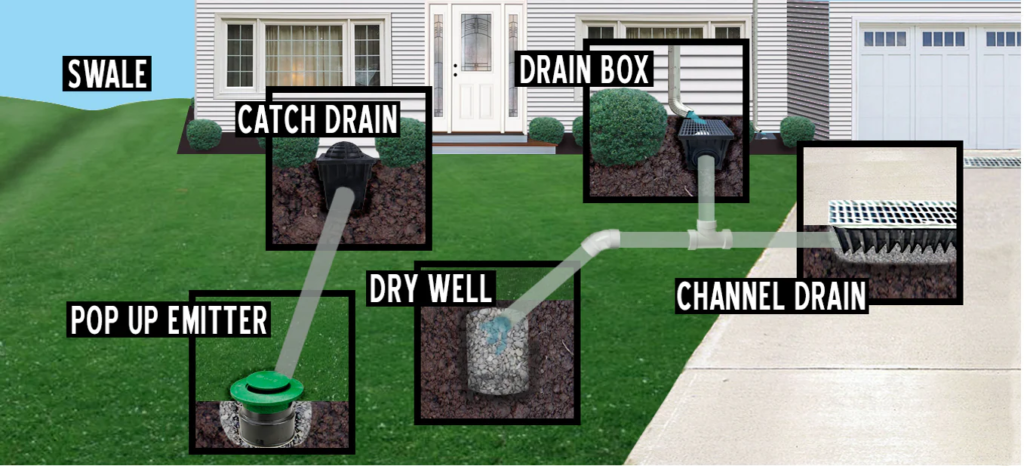


Installing drainage is essential to direct water away from your property and prevent damage caused by excess moisture, such as erosion, foundation issues, or flooding. Proper drainage ensures long-term protection for your home, lawn, or garden. Below is a step-by-step guide for installing a drainage system, whether it’s for a French drain, downspout extension, or surface drainage.
1. Planning and Preparation
- Assess the Problem Area: Determine where the water is pooling or where it flows during heavy rain. Common areas that need drainage are near foundations, patios, driveways, or low-lying areas in the yard.
- Choose the Type of Drainage: There are several types of drainage systems, including:
- French Drain: A trench filled with gravel and a perforated pipe to collect and redirect water.
- Surface Drain: Shallow drains or catch basins that collect water from the surface.
- Downspout Extension: A system to divert water from the gutters away from the foundation.
- Ensure Proper Slope: Water should flow away from structures. Ensure the drainage system has a slope of at least 1 inch per 8 feet (or 1-2% slope) to ensure water flows downhill.
2. Excavation and Trenching
- Mark the Area: Use spray paint or stakes and string to mark the path where you want to install the drainage system. For a French drain, mark a trench, usually 6 inches to 12 inches wide and 18 inches to 36 inches deep.
- Excavate the Trench: Dig a trench along the marked path, making sure to maintain the appropriate slope. You can use a shovel or trenching machine, depending on the size of the job. For a French drain, make sure the trench is deep enough for the gravel and pipe.
- Remove Rocks and Debris: Clean the trench of rocks, roots, or debris that could obstruct the flow of water or damage the pipes.
3. Installing the Drainage System
For a French Drain:
- Add a Gravel Base: Line the bottom of the trench with 2-3 inches of gravel to provide a solid foundation for the pipe.
- Install the Perforated Pipe: Lay a perforated pipe (also known as a drain pipe) on top of the gravel. The perforated side should face down so that water can enter the pipe from the bottom and flow away.
- Add More Gravel: Cover the pipe with another 2-3 inches of gravel, making sure it’s level. You may want to place a fabric filter or landscape fabric over the gravel to keep dirt and debris from entering the gravel and clogging the pipe.
- Backfill the Trench: After covering the pipe with gravel and fabric, backfill the trench with soil or dirt. If you’re installing a decorative French drain, you can use river rock or mulch on top for an aesthetically pleasing finish.
For a Surface Drain:
- Install Catch Basins: In areas where water collects, install catch basins at the lowest points. These basins collect surface water and direct it to a pipe or drain system. Dig holes large enough to accommodate the basins, and connect the basins with drain pipes.
- Place the Drain Pipe: Connect the catch basins to the desired outlet or drainage point. Lay the drain pipe with a slight slope to encourage water to flow out of the system.
- Install a Grate: After placing the pipe, install a grate over the catch basin to prevent debris from entering.
For Downspout Extensions:
- Disconnect the Downspout: Detach the existing downspout from your gutter system.
- Attach the Downspout Extension: Attach a flexible downspout extension or rigid pipe to divert water away from the foundation. Make sure it slopes away from your home, and extend it several feet (at least 4-6 feet) from the house.
- Direct the Water: Make sure the water is being directed to a storm drain, dry well, or low point in the yard.
4. Test the System
- Check for Proper Flow: After completing the installation, test the drainage system by running water through it. Check to ensure that water flows freely and that there are no blockages or pooling.
- Ensure Adequate Slope: Verify that the slope is maintained throughout the entire system and that water flows away from your foundation or other sensitive areas.
5. Finishing Touches
- Regrade the Lawn: After installing the drainage system, regrade the lawn or garden to ensure water flows away from the house and doesn’t accumulate. If needed, add topsoil and reseed or sod the area.
- Install Decorative Features: If you used a French drain or surface drain, you can cover the area with decorative rocks, pebbles, or mulch to make the drainage system more visually appealing.
- Regular Maintenance: Clean the drainage system periodically to ensure it remains clear of debris. Check catch basins, downspouts, and French drains for blockages or clogs.
Tips for Success:
- Use Quality Materials: Invest in high-quality perforated pipes, gravel, and catch basins to ensure the longevity of the system.
- Prevent Clogs: Regularly clean your gutters and downspouts to prevent debris from entering the drainage system.
- Check Local Regulations: Before installing a drainage system, check with local authorities to ensure compliance with any regulations regarding water runoff.
By following these steps, you can effectively manage water flow and protect your property from water damage. If you’re unsure about the scope of the project or local regulations, it may be a good idea to consult with a professional plumber or contractor. Let me know if you need further assistance!
